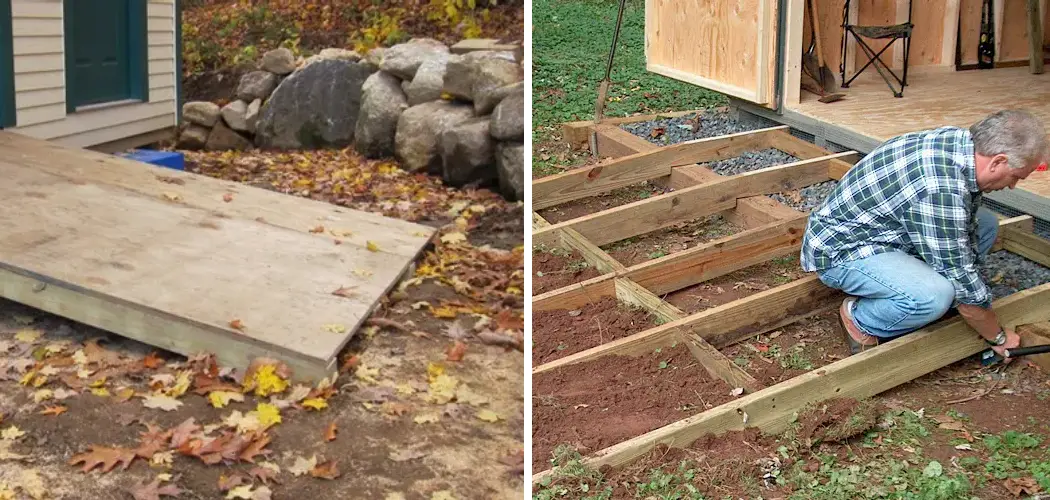Are you wondering how to build a ramp for your shed so that you can easily move heavy objects in and out? Don’t worry, it’s not as daunting a task as it may seem! With the right tools, materials and know-how, constructing a sturdy and safe ramp is easy.
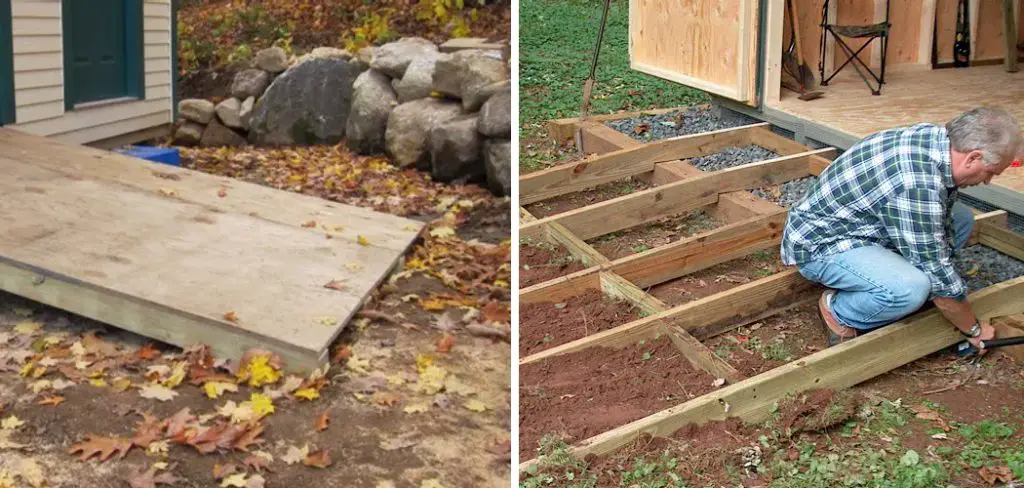
In this blog post on how to build a ramp for my shed, we’ll walk through all of the steps needed to construct a reliable homemade ramp for your shed in no time – from planning ahead to executing the build with precision. So get your toolkit ready and let’s begin!
Why Build a Ramp for Your Shed?
Before we dive into the details of how to build a ramp for your shed, let’s take a moment to understand the importance of having one. A ramp makes it easier and safer to move things like lawnmowers, wheelbarrows, and other heavy equipment in and out of your shed.
This is especially useful if you have mobility issues or are dealing with large items that cannot be lifted easily. It also prevents you from damaging your shed’s doorway and threshold by constantly pushing heavy items over them.
Now that we’ve established the need for a ramp, let’s move on to the steps involved in building one.
Materials and Tools Needed
To build a ramp for your shed, you’ll need the following materials and tools:
- Pressure-treated Lumber Boards (2x4s or 2x6s)
- Plywood Sheets
- Screws and Nails
- Gravel or Crushed Stone
- Concrete Blocks or Deck Blocks
- Level
- Circular Saw
- Drill
- Tape Measure
- Safety Gear (Gloves, Safety Glasses)
11 Step-by-step Guidelines on How to Build a Ramp for My Shed
Step 1: Measure the Area
The first step in building a ramp for your shed is to measure the area where you want to install it. This will help you determine the length and width of the ramp, as well as how much lumber and plywood sheets you need. It’s important to make sure the area is flat and that there is enough space for the ramp to slope gradually. But more on that in the next step.
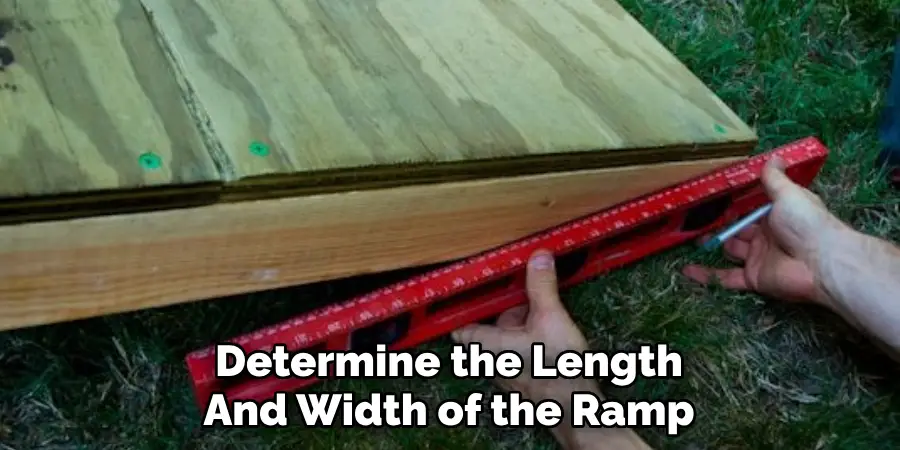
Step 2: Determine the Slope
The slope of your ramp is important for safety and functionality. If the slope is too steep, it will be difficult to push heavy objects up and down the ramp. Aim for a 1:12 slope, meaning that for every inch of vertical rise, there should be 12 inches of horizontal run. For example, if your shed’s doorway is 24 inches above the ground, your ramp should be at least 24 feet long (288 inches).
Step 3: Dig the Footings
Using a shovel, dig holes for the footings where you will place your deck blocks or concrete blocks. These footings will support the ramp and keep it stable. Make sure to follow local building codes for the required depth of the footings. You can also consult with a professional if you’re unsure. It’s always better to be safe than sorry!
Step 4: Install the Footings
Place your deck blocks or concrete blocks in the holes you dug and make sure they are level. These will serve as the base for your ramp. It’s important to have a solid foundation for your ramp, so take the time to make sure the blocks are level and secure. You can use a level and add or remove gravel or crushed stone under the blocks to achieve the desired height.
Step 5: Cut the Lumber
Using a circular saw, cut your pressure-treated lumber boards to the desired length. Remember to follow safety precautions and wear safety gear while using power tools. It’s also a good idea to have someone hold the boards while cutting to prevent them from moving and causing accidents. You will need two long boards for the sides of the ramp and shorter ones to attach to the deck blocks.
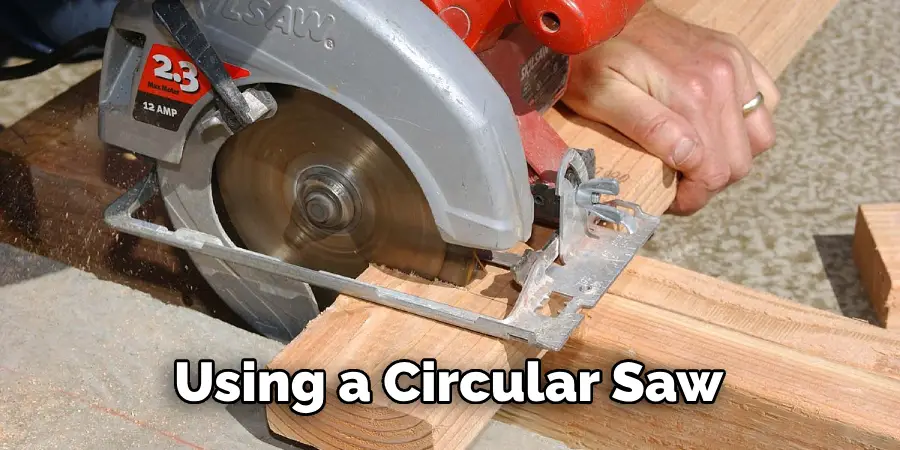
Step 6: Build the Frame
Using screws, attach the shorter lumber boards to the longer ones to create a rectangular frame. This will be the base of your ramp. Make sure everything is square and level as you go. You can also add a diagonal support board for extra stability. Otherwise, the frame may start to sag over time. It’s better to add the support now than having to fix it later.
Step 7: Attach the Plywood Sheets
Place plywood sheets on top of the frame and attach them using screws. Make sure they are secure and have no gaps between them. This will create a smooth surface for pushing objects up and down the ramp. But don’t attach the plywood sheets just yet, there’s more work to be done. You’ll need to make sure the ramp is level before securing everything in place.
Step 8: Level the Ramp
Using a level, make sure the frame and plywood sheets are level. You may need to add or remove gravel under the deck blocks to achieve this. Once everything is level, you can secure the plywood sheets using screws. It’s important to make sure the ramp is level, otherwise, it can be unsafe and unstable. It’s always better to spend a little more time on this step for the sake of safety.
Step 9: Add Handrails (Optional)
For added safety, you may choose to add handrails to your ramp. This will provide extra support when going up and down the ramp with heavy objects. You can use pressure-treated lumber boards or metal pipes for this. Simply attach them to the sides of the ramp using screws. This step is optional, but highly recommended for added safety.
Step 10: Add Non-slip Surface (Optional)
Another optional but useful step is to add a non-slip surface to your ramp. This will prevent accidents and provide better traction when pushing objects up and down. You can use outdoor carpeting, rubber mats or paint the plywood sheets with non-slip paint. This will depend on your personal preference and budget.
Step 11: Finishing Touches
Lastly, add any finishing touches to your ramp such as sanding rough edges or painting it to match your shed. You can also add a small lip at the top of the ramp to prevent objects from rolling off. And with that, your ramp is complete and ready for use! Make sure to periodically check and maintain the ramp to ensure its safety and functionality. Always remember to prioritize safety when building and using your ramp.
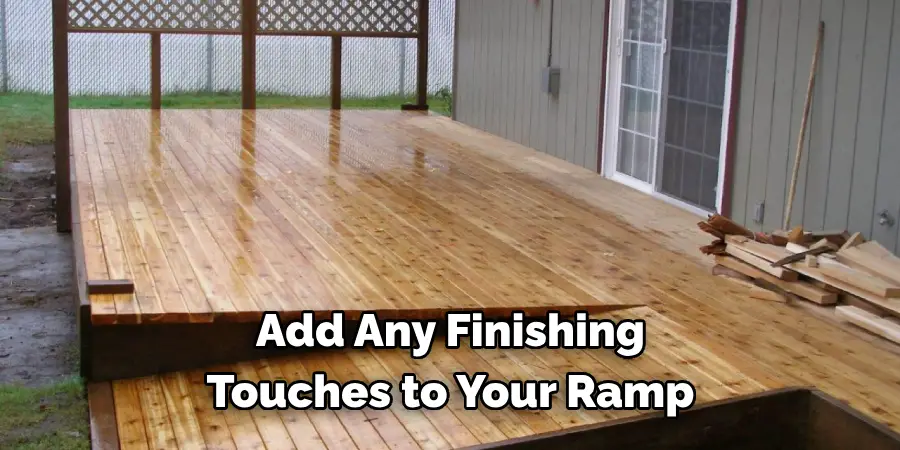
Following these guidelines on how to build a ramp for my shed will help you build a functional and safe ramp for your shed. Remember to always prioritize safety and consult with a professional if needed.
Now go out there and start building! So, in conclusion, with the right materials and tools, careful planning, and patience, you can easily build a ramp for your shed that will make your life much easier. Say goodbye to struggling with heavy objects over doorsills and uneven ground. With your new ramp, you’ll be able to effortlessly move objects in and out of your shed. Happy building!
Frequently Asked Questions
Q1. Can I Use Untreated Lumber for My Ramp?
A1. It’s not recommended to use untreated lumber for your ramp as it will not withstand the outdoor elements and can rot or warp over time. Pressure-treated lumber is a better option for durability.
Q2. Do I Need a Permit to Build a Ramp?
A2. It’s best to check with your local building codes and regulations to determine if a permit is needed for building a ramp on your property. You may also consult with a professional for guidance.
Q3. How Long Will My Ramp Last?
A3. The lifespan of your ramp will depend on the quality of materials used, weather conditions, and maintenance. With proper care and maintenance, your ramp can last for many years. So it’s important to periodically check for any signs of wear or damage and make necessary repairs. So, it’s always better to use quality materials and build a ramp that will last longer.
Q4. Can I Use the Same Steps to Build a Ramp for My Front Door?
A4. The steps outlined in this guide are specifically for building a ramp for a shed, but the same general principles can be applied to building a ramp for your front door. However, you may need to adjust certain aspects such as the length and width of the ramp to fit your specific needs. It’s also important to check with your local building codes for any additional requirements or regulations when building a ramp for your front door.
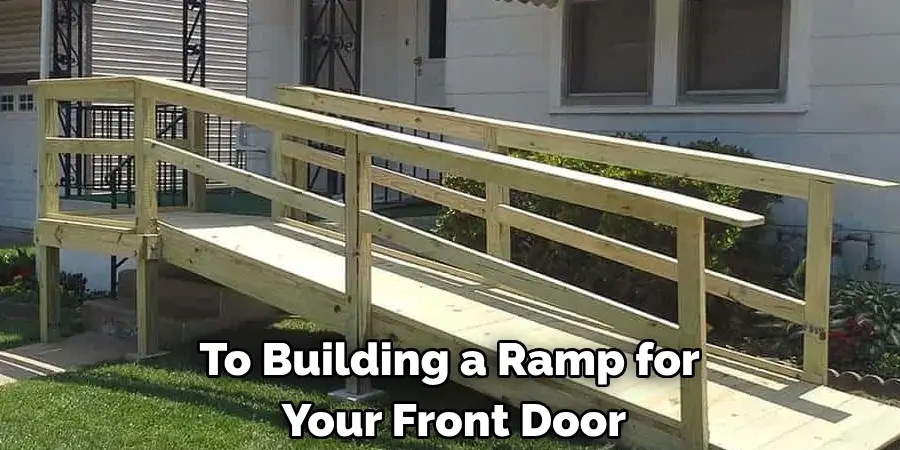
Conclusion
Building a ramp for your shed is a great way to increase accessibility and make moving objects in and out of the shed easier. With the right tools and guidelines on how to build a ramp for my shed, you’ll be able to build a sturdy and reliable ramp quickly. It’s important to ensure that all measurements are correct before you begin building so that the dimensions of your ramp will meet safety standards.
Once constructed, double-check all parts and components of the ramp to make sure it’s steady and secure before using it. Invite some friends over for help or hire a professional contractor if you’re unsure of any part of the construction process. You’ll be glad you did and can finally enjoy your new, easy-to-access shed with pride! To help get started on your project, why not visit DIY Shed Plans today for some helpful resources? Happy building!

